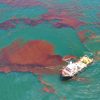Tackling Oil Spills With Magnets
The BP Deepwater Horizon oil spill in April 2010¹ poured over 205 million gallons of oil into the Gulf of Mexico. Only 25% of the oil spilled (over 51 million gallons) was recovered from the Gulf. While that seems like quite a bit of oil, in reality, it wasn’t nearly enough. Approximately 82,000 birds, 6,000 sea turtles, 25,900 marine mammals, and countless fish were harmed by the spill i. While this spill is the largest to date, it’s just one of over 320 that have occurred in the Gulf of Mexico since 1964.
How Do We Clean Up Oil?
Typically, when there’s an oil spill, the first step in cleaning it up is to contain it. Booms are the go-to for this. These are giant, floating barriers made of plastic or metal that keep the oil corralled in one area. Sorbent booms can absorb oil but don’t have the containment power of regular booms. Skimmers, boats able to soak up oil from the surface, glide across the spill area and absorb oil before it can reach more sensitive areas like the coastline.
In extreme cases, an oil slick is confined to a small area using fireproof booms and set ablaze to stop it from reaching beaches. This is referred to as in situ burning. Occasionally, dispersants are used to break up oils into the water column so that much less stays on the surface. This prevents damage to nearby beaches and tideflats.
How Can We Do Better?
Magnets, of course! Arden Warner, a physicist at the Fermi National Accelerator Laboratory, thinks magnets are the key to more efficiently cleaning up oil spills. “When you put magnetizable material in a solution, it's randomly caught up in the solution,” Warner explained. “Apply a magnetic field, and the particles will line up in the direction of the field. Orthogonally to that direction, the fluid becomes more rigid, and you can move or manipulate, it.” Arden’s initial test of his hypothesis involved iron shavings from a shovel, a small oil spill, and a magnet in his garage. When his findings proved his hypothesis, he continued on with further testing.
Crude oil, the oil most often spilled by tankers and leaked from pipelines, turned out to be easily magnetized due to its inherent viscosity (A solution’s tendency to resist flowing).
Warner’s solution involves 2-6 microns in diameter magnetite dust which can be sized down according to the depth in which they’ll need to be working. According to Warner they “mix with the oil very well, and form a very nice bond” allowing oil to be pulled up from the bottom of the water column.
Yi Du at the University of Wollongong, Australia has discovered a similar solution using iron oxide particles to bind to oil droplets.The intended outcome is that these particles will be spread into oil spills in the ocean with heavier particles sinking down to bond with the oil that has already spread below the surface. Once this is completed, boats with magnets attached to their hulls will be able to travel through the spills and collect the oil. It’s still unsure how efficient and effective this method of collection will be but hopes are high!
If cleaning up oil spills was simpler, we could save countless marine life and avoid damaging our environment. Do you think magnets could be the fix for oceanic oil spills? Share your thoughts with us on Facebook and Twitter and make sure to check out our News & How-Tos section for more magnetic stories.

